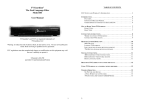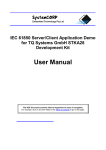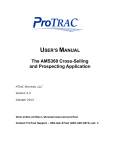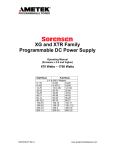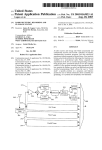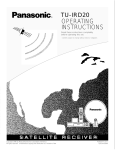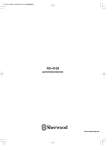Download Proson RV 2200 Owner`s manual
Transcript
5707-21128-047-0S RV 2200 AM/FM Stereo Receiver OWNER’S MANUAL Introduction UNPACKING AND INSTALLATION Congratulations on Your Purchase! Your new high fidelity receiver is designed to deliver maximum enjoyment and years of trouble free service. Please take a few moments to read this manual thoroughly. It will explain the features and operation of your unit and help ensure a trouble free installation. Please unpack your unit carefully. We recommend that you save the carton and packing material. They will be helpful if you ever need to move your unit and may be required if you ever need to return it for service. Your unit is designed to be placed in a horizontal position and it is important to allow at least two inches of space behind your unit for adequate ventilation and cabling convenience. To avoid damage, never place the unit near radiators, in front of heating vents, in direct sunlight, or in excessively humid or dusty locations. Connect your complementary components as illustrated in the following section. CAUTION RISK OF ELECTRIC SHOCK DO NOT OPEN CAUTION : TO REDUCE THE RISK OF ELECTRIC SHOCK, DO NOT REMOVE COVER (OR BACK). NO USER-SERVICEABLE PARTS INSIDE. REFER SERVICING TO QUALIFIED SERVICE PERSONNEL. This symbol is intended to alert the user to the presence of uninsulated "dangerous voltage" within the product's enclosure that may be of sufficient magnitude to constitute a risk of electric shock to persons. This symbol is intended to alert the user to the presence of important operating and maintenance (servicing) instructions in the literature accompanying the appliance. WARNING To reduce the risk of fire or electric shock, do not expose this appliance to rain or moisture. Caution : Do not block ventilation openings or stack other equipment on the top. FOR U.S.A. Note to CATV System Installer: This reminder is provided to call the CATV system installer's attention to Article 820-40 of the NEC that provides guidelines for proper grounding and, in particular, specifies that the cable ground shall be connected to the grounding system of the building, as close to the point of cable entry as practical. FCC INFORMATION This equipment has been tested and found to comply with the limits for a Class B digital device, pursuant to Part 15 of the FCC Rules. These limits are designed to provide reasonable protection against harmful interference in a residential installation. This equipment generates, uses and can radiate radio frequency energy and, if not installed and used in accordance with the instructions, may cause harmful interference to radio communications. However, there is no guarantee that interference will not occur in a particular installation. If this equipment does cause harmful interference to radio or television reception, which can be determined by turning the equipment off and on, the user is encouraged to try to correct the interference by one or more of the following measures: Reorient or relocate the receiving antenna. Increase the separation between the equipment and receiver. Connect the equipment into an outlet on a circuit different from that to which the receiver is connected. Consult the dealer or an experienced radio/TV technician for help. CAUTION: Any changes or modifications in construction of this device which are not expressly approved by the party responsible for compliance could void the user's authority to operate the equipment. Caution regarding placement (Except for U.S.A. and Canada) To maintain proper ventilation, be sure to leave a space around the unit (from the largest outer dimensions including projections) equal to, or greater than, shown below. Left and right panels: 10 cm Rear panel: 10 cm Top panel: 50 cm 2 READ THIS BEFORE OPERATING YOUR UNIT FOR U.S.A AND CANADA 120 V FOR OTHER COUNTRIES ........................ 115 V/230 V FOR YOUR SAFETY FOR YOUR SAFETY Units shipped to the U.S.A and Canada are designed for operation on 120 V AC only. Units shipped to countries other than the above countries are equipped with an AC voltage selector switch on the rear panel. Refer to the following paragraph for the proper setting of this switch. Safety precaution with use of a polarized AC plug. However, some products may be supplied with a nonpolarized plug. AC VOLTAGE SELECTION This unit operates on 115/230 V AC. The AC voltage selector switch on the rear panel is set to the voltage that prevails in the area to which the unit is shipped. Before connecting the power cord to your AC outlet, make sure that the setting position of this switch matches your line voltage. If not, it must be set to your voltage in accordance with the following direction. CAUTION : To prevent electric shock, match wide blade of plug to wide slot, fully insert. FOR CHINA, EUROPE AND AUSTRALIA ........ 220V/230V/240V FOR YOUR SAFETY Units shipped to China are designed for operation on 220 V AC only. Units shipped to Australia are designed for operation on 240 V AC only. To ensure safe operation, the three-pin plug supplied must be inserted only into a standard three-pin power point which is effectively earthed through the normal household wiring. Extension cords used with the equipment must be three-core and be correctly wired to provide connection to earth. Improper extension cords are a major cause of fatalities. The fact that the equipment operates satisfactorily does not imply that the power point is earthed and that the installation is completely safe. For your safety, if in any doubt about the effective earthing of the power point, consult a qualified electrician. PAN-EUROPEAN UNIFIED VOLTAGE All units are suitable for use on supplies 230-240 V AC. AC voltage selector switch 230 V~ 115 V~ Move switch lever to match your line voltage with a small screwdriver or other pointed tool. 3 CONTENTS Introduction UNPACKING AND INSTALLATION ...............................................................................................2 READ THIS BEFORE OPERATING YOUR UNIT ......................................................................... 3 System Connections .......................................................................................................................5 Front Panel & Remote Controls .................................................................................................. 7 REMOTE CONTROL OPERATION RANGE ................................................................................ 9 LOADING BATTERIES ................................................................................................................. 9 Operations LISTENING TO A PROGRAM SOURCE ..................................................................................... 10 LISTENING TO RADIO BROADCASTS ...................................................................................... 12 LISTENING TO RDS BROADCASTS(FM ONLY) ........................................................................ 14 RECORDING ................................................................................................................................. 15 OTHER FUNCTIONS ................................................................................................................... 16 Troubleshooting Guide ................................................................................................................. 17 Specifications .................................................................................................................................. 18 4 System Connections • Do not plug the AC input cord into the wall AC outlet until all connections are completed. • Be sure to connect the white RCA pin cords to the L(left) and the red RCA pin cords to the R(right) jacks when making audio connections. • Change the position of the FM indoor antenna until you get the best reception of your favorite FM stations. • A 75 outdoor FM antenna may be used to further improve the reception. Disconnect the indoor antenna before replacing it with the outdoor one. • Place the AM loop antenna as far as possible from the receiver, TV set, speaker cords and the AC input cord and set it to a direction for the best reception. • If the reception is poor with the AM loop antenna, an AM outdoor antenna can be used in place of the AM loop antenna. • Make connections firmly and correctly. If not, it can cause loss of sound, noise or damage to the receiver. • If the electricity fails or the AC input cord is left unplugged for more than several days, the memorized contents will be cleared. Should this happen, memorize them again. 5 6 Front Panel & Remote Controls 7 POWER SWITCH Press this switch to turn the unit standby or off. ADJUST (-,+) BUTTONS At the balance or tone mode, use these buttons to change the setting. SLEEP BUTTON Press this button to activate the sleep timer for a specified period of time. Each time this button is pressed, the sleep time changes as follows: INPUT SELECTOR BUTTONS Press the button to select the desired input source. TONE MODE BUTTON When adjusting the tone (bass and treble), press this button to select the desired tone mode. Each time this button is pressed, the tone mode is changed to bass or treble. DIMMER BUTTON Press this button to select the brightness of the fluorescent display as desired. Each time this button is pressed, the brightness of the fluorescent display changes together as follows: BALANCE BUTTON When adjusting the sound volume balance, press this button to enter the balance mode. MEMORY BUTTON Press this button to store preset stations. TUNING/PRESET UP/DOWN( BUTTONS Press these buttons to tune in the desired stations. STANDBY/ON BUTTON In the operating mode, when this button is pressed, the unit is turned off to enter the standby mode. STANDBY INDICATOR TONE DIRECT BUTTON Press this button to listen to a program source without the tone effect. REMOTE SENSOR This receives the signals from the remote control unit. TUNING MODE BUTTON Press this button to select the tuning mode or the preset mode. FLUORESCENT DISPLAY For details, see the next page. PRESET SCAN BUTTON Press this button to scan the stations in the preset sequence. VOLUME CONTROL KNOB, UP/DOWN( ) BUTTONS Adjust the volume to a comfortable listening level with this knob or these buttons. FM MODE BUTTON Press this button to select the desired FM mode. Each time this button is pressed, the FM mode is changed to the stereo mode or the mono mode. HEADPHONE JACK Stereo headphones with a standard 1/4 inch plug can be plugged into this jack for private listening. MUTING BUTTON Press this button to temporarily mute the sound. Press again to resume the previous sound level. SPEAKER A, B SELECTOR BUTTONS These buttons allow you to select various combinations of speakers as follows: To drive A speakers, press only the SPEAKER A button (“SPK A” is displayed and the speaker A indicator lights up). To drive B speakers, press only the SPEAKER B button (“SPK B” is displayed and the speaker B indicator lights up). To drive both A and B speakers, press the SPEAKER A(or B) and B(or A) buttons in order.(“SPK A B” is displayed and both of the speaker A,B indicator lights up). When using headphones for private listening, press these buttons in order to switch off the speaker A and B (“SPK OFF” is displayed). BAND BUTTON Press this button to select FM or AM. NUMERIC BUTTONS(0 ~ 9) Press these buttons to select or to store preset stations directly. RDS BUTTON Press this button to select RDS mode. SEARCH MODE BUTTON Press this button to select Search mode. PTY SELECT BUTTON Press this button to select Type of programs. 8 FLUORESCENT DISPLAY LOADING BATTERIES REMOTE CONTROLOPERATION RANGE Use the remote control unit within a range of about 7 meters (23 feet) and angles of up to 30 degrees aiming at the remote sensor. 1 Remove the cover. 2 Load two batteries matching the polarity. Remove the batteries when they are not used for a long time. Do not use the rechargeable batteries(Ni-Cd type). 9 Operations LISTENING TO APROGRAM SOURCE Before operation Push the POWER switch • This unit enters the standby mode. The lighting of STANDBY indicator means that the receiver is not disconnected from the AC mains and a small amount of current is retained to support the memorized contents and operation readiness. •To switch the power off, push the POWER switch again. Then the power is cut off and the STANDBY indicator goes off. 1 Turn the power on. 2 When the POWER button on the remote control is pressed, this unit is turned on to enter the operating mode. In the standby mode, if an INPUT SELECTOR button is pressed, the unit is turned on automatically and the desired input is selected. In the operating mode, when the POWER button on the remote control is pressed, then it enters the standby mode. 3 Select the desired input source. Then the corresponding speaker indication(“SPK A(or/and) B” is displayed and the sound can be heard from the speakers connected to the selected speaker terminals. when ON is selected, the "SPEAKER A (or/ and) B" indicator lights. When using the headphones for private listening, press the corresponding SPEAKER button to switch off both A and B speakers. 4 5 Each time the FM/AM button on the front panel or the TUNER button on the remote control is pressed, the band is changed to AM or FM. 10 Switch the desired speakers on. Operate the selected component for playback. Adjust the volume to a comfortable listening level. 6 To mute the sound. 7 “MUTE” lights up and flickers. To resume the previous sound level, press this button again. Be sure to switch off both A and B speakers. Adjusting the tone(bass and treble) 8 To listen with the headphones. 9 Enter the tone mode. Each time this button is pressed, the corresponding tone mode is selected and shown for 3 seconds as follows: At the desired tone mode, adjust the tone as desired. If the tone display disappears, start from the step 8 again. Notes: Extreme settings at high volume may damage your speakers. In general, the bass and treble levels are adjusted to 0. Note: When the tone direct function is activated, the tone mode cannot be entered and “TON DIR” flickers for 3 seconds. To listen to a program source without the tone effect. 10 “TON DIR” is displayed and the sound that bypasses the tone circuitry will be heard. To cancel the tone direct function, press this button again to display “TON CTRL”. Adjusting the sound volume balance 11 12 Enter the balance mode. “BAL” and the balance level is displayed for 3 seconds. Adjust the sound volume balance between the left and right speakers. If the balance display disappears, start from the step 11 again. Note: In general, the balance level is set to 0. 11 LISTENING TO RADIO BROADCASTS Auto tuning 1 Select the tuner and then the desired band. • Each time this button is pressed, the band is changed to FM or AM. 2 Select the tuning mode. 3 • Each time this button is pressed, the mode changes as follows: Press the TUNING/PRESET UP( ) or DOWN( ) button for more than 0.5 second. • The tuner will now search until a station of sufficient strength has been found. The display shows the tuned frequency and “TUNED”. • If the station found is not the desired one, simply repeat this operation. • Weak stations are skipped during auto tuning. Manual tuning • Manual tuning is useful when you already know the frequency of the desired station. • Perform the steps 1 and 2 in “Auto tuning” procedure and press the TUNING/PRESET UP( ) or DOWN( ) button repeatedly until the right frequency has been reached. Presetting radio stations 2 • You can store up to 30 preferred stations in the memory. 1 Press the MEMORY button. Tune in the desired station with auto or manual tuning. • “MEM” is flickering for 5 seconds. 12 3 Select the desired preset number (1~30) and press the MEMORY button. 4 • When using the NUMERIC buttons on the remote control. Examples) For “3” : For “15” : For “30” : • The station has now been stored in the memory. • When using the NUMERIC buttons, the station is stored automatically without pressing the MEMORY button. • A stored frequency is erased from the memory by storing another frequency in its place. • If “MEM” goes off, start again from the above step 2. Tuning to preset stations 1 MEMORY BACKUP FUNCTION The following items, set before the receiver is turned off, are memorized. • INPUT SELECTOR settings • Preset stations,etc. Note • If the electricity fails or the AC input cord is disconnected for more than several days, they are all cleared. So you should memorize them again. 2 After selecting the tuner as an input source, select the preset mode. Repeat the above steps 1 to 3 to memorize other stations. Select the desired preset number. • When using the NUMERIC buttons on the remote control. Examples) For “3” : For “15” : For “30” : • To select numbers less than 10, press "0" and then the number. As an example, to select number 5, press "0" and "5". (Optionally, you may press just the number "5" and then wait a few seconds.) • Then “PRESET” lights up. Scanning preset stations in sequence Listening to FM stereo broadcasts • While listening to FM broadcasts, • Each time this button is pressed, the FM mode changes as follows: • When FM stereo broadcasts are poor because of weak broadcast signals, select the FM mono mode to reduce the noise, then FM broadcasts are reproduced in monaural sound. 13 • The receiver will start scanning the stations in the preset sequence. • At the desired station, press this button again to stop scanning. LISTENING TO RDS BROADCASTS(FM ONLY) RDS(Radio Data System) is a method for sending information signals together with the transmitter signals. Your tuner is capable of translating these signals and putting the information on the display. These codes contain the following informations. Program Service name(PS), A list of Program Types(PTY), Traffic Announcement(TA), Clock Time(CT), Radio Text(RT). RDS search 2 • Use this function to automatically search and receive the stations offering RDS services. 1 In the FM mode, select the RDS search mode. • The tuner automatically searches stations offering RDS services and the station name is displayed. • If the station found is not the desired one, press ) or DOWN( ) the TUNING/PRESET UP( button again while the RDS indicator is flickering. • If no other RDS station is found, “NO RDS” is displayed. • When “RDS SRCH” is not displayed, repeat again from the above step 1. • Each time this button is pressed, the search mode changes as follows; TP search 2 • Use this function to automatically search and receive the stations broadcasting the traffic program. In the FM mode, select the TP search mode. 1 While displaying “TP SRCH”. • The tuner automatically searches for stations broadcasting the traffic program. • “NO TP”is displayed if the signal is too weak or there are no stations broadcasting the traffic program. • When “TP SRCH” is not displayed, repeat again from the above step 1. • “TP SRCH” is displayed. PTY search 2 • Use this function to automatically search and receive the stations broadcasting the desired program type. 1 While displaying “RDS SRCH” While displaying “PTY SRCH”, select the desired program type. In the FM mode, select the PTY search mode. • Each time this button is pressed, one of 32 different types of programs is selected. (NEWS, AFFAIRS, INFO, SPORT, EDUCATE, DRAMA, CULTURE, SCIENCE, VARIED, POP M, ROCK M, EASY M, LIGHT M, CLASSICS, OTHER M, WEATHER, FINANCE, CHILDREN, SOCIAL, RELIGION, PHONE IN, TRAVEL, LEISURE, JAZZ, COUNTRY, NATION M, OLDIES, FOLK M, DOCUMENT, TEST, ALARM, NONE) • When “PTY SRCH” is not displayed, repeat again from the above step 1. • “PTY SRCH” is displayed. 14 3 • The tuner automatically searches a station offering PTY services. • If no station is found, “NO PTY” is displayed. RDS In the FM mode. • Each time this button is pressed, the display mode changes as follows; Frequency Program Service name (PS) Program Type (PTY) Clock Time (CT) Radio Text (RT) • If the signals are too weak or no RDS service is available, “NO NAME”, “NO PTY”, “NO TIME” or “NO TEXT” will be displayed. RECORDING The volume, tone(bass, treble) and balance settings have no effect on the recording signals. When you select tuner, CD or AUX as a recording source, recording may be made on TAPE or VIDEO, or both simultaneously. Recording with TAPE 1 Select the desired input as a recording source except for TAPE. 2 Start recording on the TAPE. 3 Start play on the desired input. 15 Recording with VIDEO 1 Select the desired input as a recording source except for VIDEO. 2 Start recording on the VIDEO. 3 Start play on the desired input. The audio signals from the desired input will be recorded onto the VIDEO. OTHER FUNCTIONS Operating the sleep timer Adjusting the brightness of the fluorescent display The sleep timer allows the system to continue to operate for a specified period of time before automatically shutting off. To set the receiver to automatically turn off after the specified period of time. Each time this button is pressed, the sleep time changes as follows: Each time this button is pressed, the brightness of the fluorescent display changes together as follows: While operating the sleep timer, SLEEP indicator lights up. When the sleep time is selected, the fluorescent display is dimly lit. In the display OFF mode, pressing any button will restore the display ON mode. 16 Troubleshooting Guide If a fault occurs, run through the table below before taking your receiver for repair. If the fault persists, attempt to solve it by switching the receiver off and on again. If this fails to resolve the situation, consult with your dealer. Under no circumstances should you repair the receiver yourself as this could invalidate the warranty. PROBLEM POSSIBLE CAUSE REMEDY No power • The AC input cord is disconnected. • Poor connection at AC wall outlet or the outlet is inactive. • Connect the cord securely. • Check the outlet using a lamp or another appliance. No sound • The speaker cords are disconnected. • The volume is adjusted too low. • The MUTING button on the remote control is pressed to ON. • Speakers are not switched on. • Incorrect selection of the input source. • Incorrect connections between the components. • Check the speaker connections. • Adjust the volume. • Press the MUTING button to cancel the muting effect. • Press the SPEAKER A or B button to ON. • Select the desired input source correctly. • Make connections correctly. Stations cannot be received • No antenna is connected. • The desired station frequency is not tuned in. • The antenna is in wrong position. • Connect an antenna. • Tune in the desired station frequency. • An incorrect station frequency has been memorized. • The memorized stations are cleared. • Memorize the correct station frequency. Poor FM reception • No antenna is connected. • The antenna is not positioned for the best reception. • Connect an antenna. • Change the position of the antenna. Continuous hissing noise during FM reception, especially when a stereo broadcast is received. • Weak signals. • Change the position of the antenna. • Install an outdoor antenna. Continuous or intermittent hissing noise during AM reception, especially at night. • Noise is caused by motors, fluorescent lamps or lightning, etc. • Keep the receiver away from noise sources. • Install an outdoor AM antenna. No recording • Incorrect selection between the components. • Incorrect operation of each component for playback and recording. • Make connections correctly. • Batteries are not loaded or exhausted. • The remote sensor is obstructed. • Replace the batteries. • Remove the obstacle. Preset stations cannot be received Remote control unit does not operate. 17 • Move the antenna and retry tuning. • Memorize the stations again. • Operate each component correctly. Specifications AMPLIFIER SECTION Power output, stereo mode, 8 Ω, THD 0.2 %, 20 Hz~20 kHz ................................................................ 2X100 W Total harmonic distortion, 8 Ω, 100 W, 20 Hz~20 kHz ............................................................................. 0.04 % Intermodulation distortion 60 Hz : 7 kHz= 4 : 1 SMPTE, 8 Ω, 100 W ................................................................................................... 0.1 % Input sensitivity, 47 kΩ Line .......................................................................................................................................................... 200 mV Signal to noise ratio, IHF “A” weighted Line ............................................................................................................................................................. 95 dB Frequency response Line, 10 Hz~100 kHz ................................................................................................................................ 3 dB Output level TAPE/VCR OUT, 2.2 kΩ .......................................................................................................................... 200 mV Bass/Treble control, 100 Hz/10 kHz ........................................................................................................ 10 dB FM TUNER SECTION Tuning frequency range ................................................................................................................ 87.5~108 MHz Usable sensitivity, THD 3%, S/N 30 dB ..................................................................................................... 15 dBf 50 dB quieting sensitivity, mono/stereo .......................................................................................... 25.2/45.2 dBf Signal to noise ratio, 65 dBf, mono/stereo ............................................................................................. 68/65 dB Total harmonic distortion, 65 dBf, 1 kHz, mono/stereo .......................................................................... 0.5/0.8% Frequency response, 25 Hz~14 kHz ......................................................................................................... 3 dB Stereo separation, 1 kHz ............................................................................................................................ 35 dB Capture ratio ................................................................................................................................................ 4 dB IF rejection ratio .......................................................................................................................................... 80 dB AM TUNER SECTION Tuning frequency range ................................................................................................................ 522~1611 kHz Usable sensitivity .................................................................................................................................... 800 V/m Signal to noise ratio .................................................................................................................................... 40 dB Selectivity ................................................................................................................................................... 25 dB GENERAL Power supply .................................................................................................................................. 230V~ 50 Hz Power consumption ................................................................................................................................... 200W Dimensions (W H D) ......................................................... 440 138 332 mm(17-3/8 5-7/16 13 inches) Weight (Net) ............................................................................................................................. 9.0 kg(19.85 lbs) Note: Design and specifications are subject to change without notice for improvements. 18



















